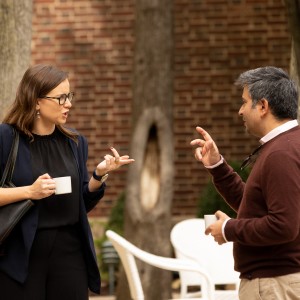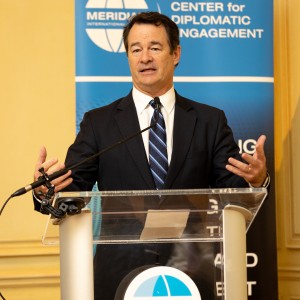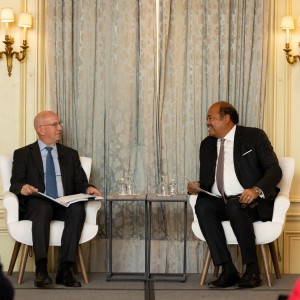U.S. Ambassador to the OECD Jack Markell Discusses the Blue Dot Network at Meridian

The Blue Dot Network, initiated by Australia, Japan, and the U.S., aims to have third-party certification to bridge the gap of $2.5-3.5 trillion of infrastructure projects with private sector support. On Wednesday, October 12, Meridian hosted an Insights@Meridian program featuring The Honorable Jack Markell, U.S. Ambassador and Permanent Representative to the OECD, for a moderated conversation with Fred Humphries, Vice President of Corporate and U.S. Government Affairs at Microsoft. Here are the top takeaways.
- BDN Certification Follows Already-Established Benchmarks
The Blue Dot Network certification requirements are not starting from scratch-- the infrastructure standards are based on the G20 Principles for Quality Infrastructure Investment, the G7 Charlevoix Commitment on Innovative Financing for Development, Paris Agreement, and IFC Performance Standards. These benchmarks are intended to be credible but not onerous and will allow countries to attract infrastructure investment. Through the OECD’s Trust in Business Initiative, OECD has developed a uniform methodology to assess BDN projects.
- BDN Certification Will Be Applied Across an Array of Infrastructure Sectors
BDN Certification for infrastructure projects cuts across all sectors including roads, ports, and digital and technology. These projects will have universal implementation standards including environmental and social impact assessments, anti-corruption systems, and mechanisms to enable local community input. However, some technical standards may be based on the sector, so that a data center will not have the same metrics for assessment as a modernized port.
- Blue Dot Network Elements Push Towards a More Equitable Future
The BDN consists of ten elements to ensure quality infrastructure including promoting sustainable and inclusive economic growth and development; building projects that are resilient to climate change and other risks; promoting non-discriminatory use of infrastructure services; and advancing inclusion for women, people with disabilities, and underrepresented and marginalized groups. These elements will ensure there is local ownership and greater participation in society for BDN certified projects. Indeed, the elements will also drive the public and private sector on the inevitable path towards green energy. The elements are all-encompassing and will increase transparency and ensure value-for-money for the parties involved.
- The Private Sector Plays a Key Role in the BDN
The private sector has played a vital role in the development of BDN. The OECD-organized Executive Consultation Group, comprised of nearly 200 private sector and civil society partners, has been meeting to provide guidance on the best path forward to implement BDN certified projects. When launched, companies can have confidence in investing in BDN-certified projects because the projects will provide a higher degree of transparency, rule of law, and environmental and social standards. BDN projects are aimed to be a win-win situation for both the private sector and sovereign states.
- Be Prepared for Upcoming BDN Projects
The BDN is moving from conceptualization to implementation beginning with pilot projects around the world. BDN projects can help countries attract the necessary investment into needed infrastructure without sacrificing the labor standards, certainty in safety and sustainability, and local ownership. These upcoming projects are a tool for countries to make market-driven investments based on principled standards.
Resources:
The Blue Dot Network – A proposal for a global certification framework for quality infrastructur
Blue Dot Network - United States Department of State
Project summary
| U.S. Ambassador to the OECD Jack Markell Discusses the Blue Dot Network at Meridian | October 2022 | |
|---|---|
| Number of Attendees: | 60 |
| Regions: | East Asia and Pacific, Europe and Eurasia |
| Countries: | Brazil, Germany, Norway, Poland, Romania, Singapore, Switzerland |
| Impact Areas: | Business and Trade, Energy and the Environment, Governance and Transparency, Science and Technology, Transportation |
| Program Areas: | Diplomatic Engagement |
| Partners: | Diplomatic Corps, Private Sector, Public Sector |








